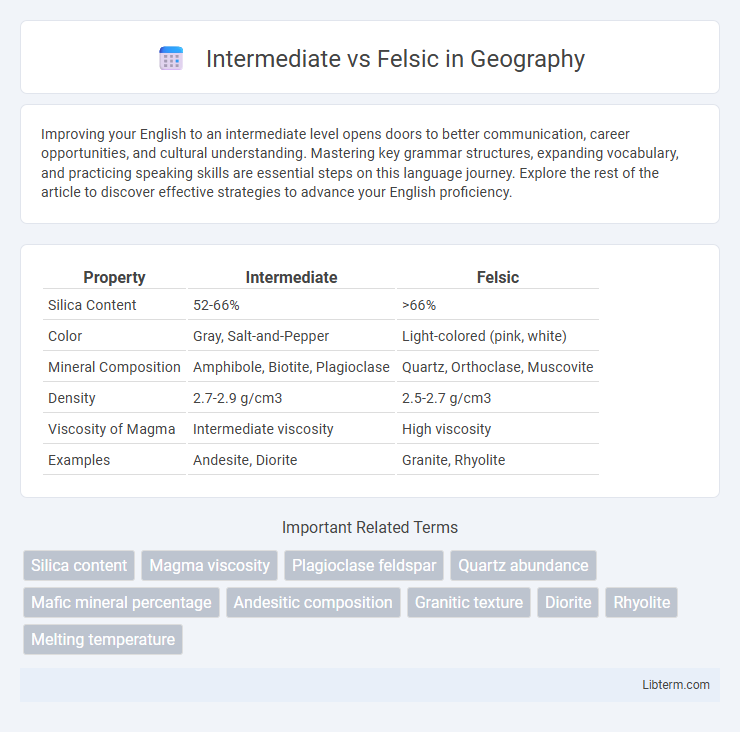Improving your English to an intermediate level opens doors to better communication, career opportunities, and cultural understanding. Mastering key grammar structures, expanding vocabulary, and practicing speaking skills are essential steps on this language journey. Explore the rest of the article to discover effective strategies to advance your English proficiency.
Table of Comparison
| Property | Intermediate | Felsic |
|---|---|---|
| Silica Content | 52-66% | >66% |
| Color | Gray, Salt-and-Pepper | Light-colored (pink, white) |
| Mineral Composition | Amphibole, Biotite, Plagioclase | Quartz, Orthoclase, Muscovite |
| Density | 2.7-2.9 g/cm3 | 2.5-2.7 g/cm3 |
| Viscosity of Magma | Intermediate viscosity | High viscosity |
| Examples | Andesite, Diorite | Granite, Rhyolite |
Understanding Igneous Rock Classification
Intermediate igneous rocks, such as diorite and andesite, contain moderate silica content (52-63%) and typically exhibit a balance of light and dark minerals, distinguishing them from felsic rocks that have higher silica content (above 63%) and are rich in quartz and feldspar. Felsic rocks like granite and rhyolite are lighter in color and less dense due to their high silica and potassium feldspar content, influencing their formation in continental crust settings. Understanding this classification aids geologists in interpreting magmatic processes and the tectonic environment where these rocks crystallized.
Mineral Composition: Intermediate vs Felsic
Intermediate igneous rocks contain moderate amounts of silica, typically between 52-66%, with abundant plagioclase feldspar and amphibole minerals such as hornblende, reflecting a balanced mineral composition between mafic and felsic types. Felsic rocks possess higher silica content, exceeding 66%, and are rich in quartz, potassium feldspar, and mica, resulting in lighter colors and lower density compared to intermediate rocks. The mineral composition in intermediate rocks indicates a transitional chemistry, whereas felsic rocks showcase evolved magmas with minerals formed under lower temperatures and higher silica saturation.
Color and Texture Differences
Intermediate igneous rocks typically exhibit a medium gray to greenish color, reflecting their balanced mineral composition between mafic and felsic. Felsic rocks usually display lighter colors such as white, pink, or light gray due to higher silica and feldspar content. Texturally, intermediate rocks often have a porphyritic texture with visible crystals embedded in a finer matrix, while felsic rocks tend to have a coarse-grained texture dominated by quartz and feldspar minerals.
Formation Processes of Intermediate Rocks
Intermediate rocks form through the partial melting of the Earth's crust, typically involving a mix of mafic and felsic components. They crystallize from magma with moderate silica content, generally between 52% and 63%, resulting in minerals like amphibole, biotite, and plagioclase. These processes often occur at convergent plate boundaries where subduction introduces water and triggers differentiation, producing intermediate compositions such as diorite and andesite.
Formation Processes of Felsic Rocks
Felsic rocks form primarily through the slow cooling and crystallization of silica-rich magma, typically within continental crust environments. The high silica content in felsic magma increases its viscosity, leading to the formation of light-colored minerals such as quartz, feldspar, and muscovite during solidification. These formation processes distinguish felsic rocks from intermediate rocks, which contain lower silica levels and crystallize from magma with a different chemical composition.
Major Examples: Andesite vs Granite
Andesite, a typical intermediate volcanic rock, contains moderate silica content (57-63%) and is rich in plagioclase with some amphibole and biotite, commonly found in volcanic arcs like the Andes Mountains. Granite, a felsic intrusive rock, has high silica content (70-77%) with abundant quartz, alkali feldspar, and mica, forming large, coarse-grained textures often present in continental crust and mountain plutons. Both rocks illustrate key differences in texture and mineral composition linked to their formation environments, with andesite representing volcanic activity and granite solidifying slowly underground.
Chemical Properties and Silica Content
Intermediate igneous rocks contain 52-63% silica (SiO2), placing them between mafic and felsic compositions in terms of chemical properties. Felsic rocks, such as granite, typically have higher silica content, exceeding 65%, which results in lower iron, magnesium, and calcium concentrations compared to intermediate rocks. This elevated silica content in felsic rocks contributes to their higher viscosity and lighter mineralogy, dominated by quartz and feldspar.
Geological Settings and Occurrences
Intermediate igneous rocks, such as andesite and diorite, typically form in subduction zone settings where oceanic crust descends beneath continental or oceanic plates, producing magma with moderate silica content. Felsic rocks like granite and rhyolite commonly occur in continental crust regions, often associated with volcanic arcs, continental rift zones, and continental collision environments where high silica magmas evolve from extensive crustal melting. Geological occurrences of intermediate rocks are frequently linked to island arcs and volcanic arcs, while felsic rocks dominate continental batholiths and extensive volcanic plateaus.
Uses and Applications in Industry
Intermediate igneous rocks, such as andesite and diorite, are widely used in construction and road building due to their durability and moderate silica content, providing a balance between strength and workability. Felsic rocks like granite and rhyolite are highly valued in the architectural and decorative stone industries for their high silica content, aesthetic appeal, and resistance to weathering. Both rock types serve distinct purposes in engineering, manufacturing, and ornamental applications based on their mineral composition and physical properties.
Identifying Intermediate and Felsic Rocks in the Field
Intermediate and felsic rocks are identified in the field primarily by their mineral composition and color; intermediate rocks typically exhibit a mix of light and dark minerals with moderate silica content, while felsic rocks are lighter in color and rich in quartz and feldspar minerals. Observing grain size helps distinguish them, as felsic rocks often have coarse grains indicating slower cooling, whereas intermediate rocks may have finer grains showing a quicker cooling process. Field geologists use tools like hand lenses and color charts to accurately classify these rocks based on texture, mineral presence, and color intensity.
Intermediate Infographic

 libterm.com
libterm.com